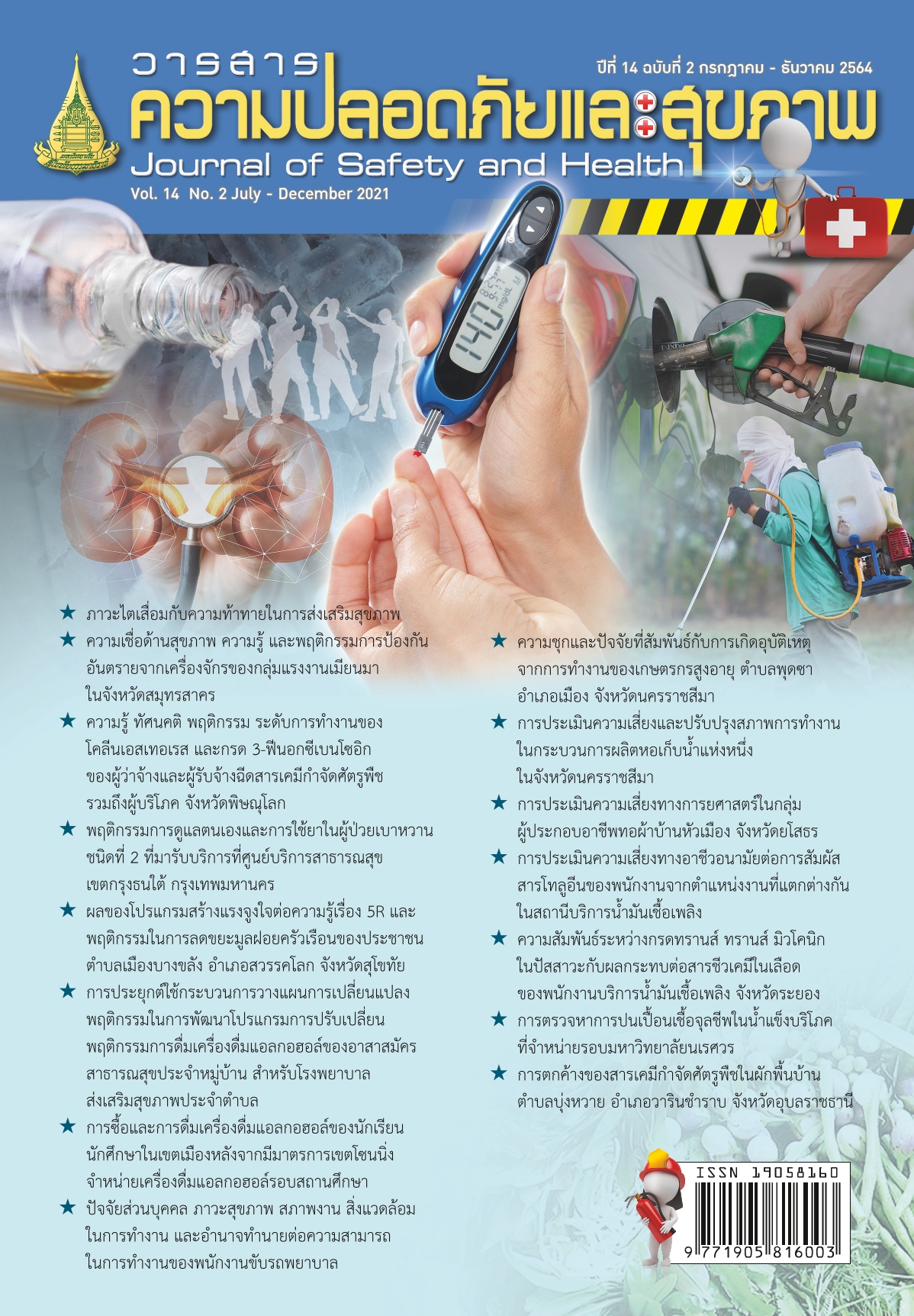การตกค้างของสารเคมีกำจัดศัตรูพืชในผักพื้นบ้าน ตำบลบุ่งหวาย อำเภอวารินชำราบ จังหวัดอุบลราชธานี
Main Article Content
บทคัดย่อ
การวิจัยเชิงพรรณนาแบบภาคตัดขวางนี้มีวัตถุประสงค์เพื่อศึกษาการตกค้างของสารเคมีในผักพื้นบ้านจาก 95 ครัวเรือนที่ปลูกผักพื้นบ้านในพื้นที่ตำบลบุ่งหวาย อำเภอวารินชำราบ จังหวัดอุบลราชธานี โดยผักพื้นบ้านได้แก่ ผักแขยงและใบบัวบก จำนวน 116 ตัวอย่าง ทำการทดสอบการตกค้างของสารเคมีกำจัดศัตรูพืชด้วยชุดทดสอบจีที วิเคราะห์ผลโดยใช้สถิติเชิงพรรณนา ได้แก่ ความถี่และร้อยละ ผลการศึกษาพบว่า ในผักแขยงไม่พบการตกค้างของสารเคมีกำจัดศัตรูพืช ร้อยละ 58.90 พบตกค้างแต่อยู่ในเกณฑ์ปลอดภัย ร้อยละ 31.51 และพบตกค้างในปริมาณเกินเกณฑ์ปลอดภัย ร้อยละ 9.59 ในใบบัวบกไม่พบการตกค้างของสารเคมีกำจัดศัตรูพืช ร้อยละ 46.51 พบตกค้างแต่อยู่ในเกณฑ์ปลอดภัย ร้อยละ 41.86 และพบตกค้างในปริมาณเกินเกณฑ์ปลอดภัย ร้อยละ 11.63 ดังนั้นหน่วยงานที่เกี่ยวข้อง ควรสนับสนุนการปลูกผักพื้นบ้านที่ปลอดสารพิษให้มากขึ้น เพื่อลดผลกระทบต่อทั้งตัวเกษตรกรและผู้บริโภคผักพื้นบ้านต่อไป
Article Details
Journal of Safety and Health is licensed under a Creative Commons Attribution-NonCommercial-NoDerivatives 4.0 International (CC BY-NC-ND 4.0) licence, unless otherwise stated.
เอกสารอ้างอิง
[2] Muhammed Alamgir Zaman Chowdhury, Iffat Jahan, Nurul Karim, Mohammad Khorshed Alam, Mohammad Abdur Rahman, Mohammed Moniruzzaman, Siew Hua Gan, Abu Naieum Muhammad Fakhruddin. (2014). Determination of Carbamate and Organophosphorus Pesticides in Vegetable Samples and the Efficiency of Gamma-Radiation in Their Removal. BioMed Research International. 2014,1-9.
[3] Mildred Mwanja. (2017). Assessment of pesticide residue levels among locally produced fruits and vegetables in Monze district, Zambia. International Journal of Food and Contamination.4(11).1-9.
[4] Surat Hongsibsong, Tippawan Prapamontol, Ting Xu, Bruce D. Hammock, Hong Wang, Zi-Jian Chen, AND Zhen-Lin Xu. (2020). Monitoring of the organophosphate Pesticide Chlorpyrofos in vegetable samples from local markets in Northern Thailand by Developed Immunoassay. Environmental Research and Public Health. 17,1-14.
[5] Department of Medical Science. (2019,October). Pesticide residues in fruits and vegetables. Retrieved May 12 2020, from https://pr.moph.go.th/?url=pr/detail/2/02/133244
[6] Supaporn Chaigarun, Sangwan Somboon, and Samart Wanchana. (2013) Insecticide residues in Isan vegetable and local foods. KKU Journal for Public Health Research. 6(3). 122 – 129.
[7] Department of Medical Science. (2013). Product and Test kit. Retrieved May 12 2020, from http://www.dmsc.moph.go.th/bkm/product_detail.php?id=21
[8] Kwong, T.C., (2002). Organophosphate pesticides: biochemistry and clinical toxicology. Ther. Drug Monit. 24, 144–149.
[9] Wijitra Liaotrakoon, Vachiraya Liaotrakoon, Priyanoot Peanleangchep, and Raweewon Duamkhanmanee.(2020). Detection of Organophosphate and carbamate pesticide residues on fresh vegetables in Phra Nakhon Si Ayutthayan Province and AEffectiveness of washing methods on pesticide residues in kale. King Mongkut’s Agr.J. 38(1).131-138.
[10] Pattama Senthong, Kodchapan Noochana, Jantima Aekrucharit, Tamawat Saimetha, Jirakit Doungmusik, Pakinee Piyapun, and Klittapop Saithongkam. Pesticide residues in soil, drinking water and vegetables in household in rambutan and durian farms. KKU Research Jounal (Graduate Studies). 20(3). 86-94.
[11] Sara Mostafalou and Mohammad Abdollahi. (2017). Pesticides: an update of human exposure and toxicity. Arch Toxicol. 91, 529-599.
[12] SANA AKHTAR, GHAZALA YAQUB, ALMAS HAMID, ZAINAB AFZAL, AND SIDRA ASGHAR. (2018). Determination of pesticide residues in selected vegetables and fruits from a Local market of Lahore, Pakistan. Current World Environment.13(2).242-250.


